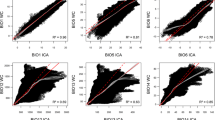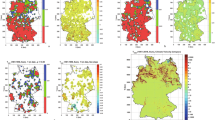Abstract
Key message
We identified the climate zones where the climate has highest variation similarity to aid to climate data selection.
Abstract
The calculation of climate-growth correlations is the analytical foundation to study climate change influence on tree growth in dendrochronology. However, the majority of climate data used in climate-growth correlation analyses are not directly recorded on the sample sites, but obtained from nearby weather stations. We used a sample site in Saihanba region as a case study to address how correlation bias may occur if nearby climate products have no high correlation with the climate in the sample site. Temperatures in the sample site and from other data resources were highly correlated, suggesting that small potential bias in growth-temperature correlations when using temperatures from nearby climate stations. However, precipitation had large spatial variability, resulting in low correlation between precipitation of the sample site and precipitation from other resources. Large biases in growth-precipitation analysis would be expected when using precipitation from nearby stations, suggesting that precipitation records should be carefully chosen. To aid in this selection, we used a cluster analysis and multiple data-products across China to identify regions where station climate do and do not reflect accurately site conditions, and classified temperature and precipitation zones where climate has high correlation among grid cells of the same climate zone based on similarity of the macroclimate using a ~ 2.5 km resolution gridded climate dataset. Using climate stations located in the same cluster as the sample sites would help to prevent or reduce correlation biases in growth-climate analyses. The generated temperature and precipitation zones are freely available to download as GeoTIFF files in the online supplementary materials (Fig. 1S and Fig. 2S).





Similar content being viewed by others
References
Allen RJ, Degaetano AT (2000) A method to adjust long-term temperature extreme series for nonclimatic inhomogeneities. J Clim 13(13):3680–3695
Belda M, Holtanová E, Halenka T et al (2014) Climate classification revisited: from Köppen to Trewartha. Clim Res 59(1):1–13
Blasing TJ, Duvick DN, West DC (1981) Dendroclimatic calibration and verification using regionally averaged and single station precipitation data. Tree Ring Bull 41:37–43
Cook ER, Holmes RL (1986) Users manual for the program ARSTAN. Laboratory of Tree-Ring Research, University of Arizona, Tucson
Cook ER, Kairiukstis LA (1990) Methods of dendrochronology. Kluver, Dordrecht
Franke J, Frank D, Raible C, Esper J, Brönnimann S (2013) Spectral biases in tree-ring climate proxies. Nat Clim Change 3(4):360–364
Friedman JH (1984) A variable span smoother. Technical Report 5, Vol. Stanford University, Laboratory for Computational Statistics, Department of Statistics, Stanford, CA
Grießinger J et al (2018) Imprints of Climate Signals in a 204 Year δ18O Tree-Ring Record of Nothofagus pumilio From Perito Moreno Glacier, Southern Patagonia (50°S). Front Earth Sci 6(27):27
Harris I, Jones PD, Osborn TJ, Lister DH (2014) Updated high-resolution grids of monthly climatic observations—the CRU TS3. 10 Dataset. Int J Climatol 34:623–642
He M, Yang B, Bräuning A, Rossi S, Ljungqvist FC, Shishov V, Grießinger J, Wang J, Liu J, Qin C (2019) Recent advances in dendroclimatology in China. Earth Sci Rev 194:521–535
Holmes RL (1983) Computer-assisted quality control in treering dating and measurement. Tree Ring Bull 43:69–78
Klesse S, DeRose RJ, Guiterman CH, Lynch AM, O’Connor CD, Shaw JD, Evans MEK (2018) Sampling bias overestimates climate change impacts on forest growth in the southwestern United States. Nat Commun 9(1):1–9
Netzel P, Stepinski T (2016) On using a clustering approach for global climate classification. J Clim 29(9):160222131641003
Pearl JK, Keck JR, Tintor W, Siekacz L, Herrick HM, Meko MD, Pearson CL (2020) New frontiers in tree-ring research. Holocene. https://doi.org/10.1177/0959683620902230
Pederson N, Jacoby GC, D’arrigo RD, Cook ER, Buckley BM (2001) Hydrometeorological reconstructions for northeastern Mongolia derived from tree rings: 1651–1995. J Clim 14:872–881
Rozendaal DM, Zuidema PA (2011) Dendroecology in the tropics: a review. Trees 25(1):3–16
Schweingruber FH, Hellmann L, Tegel W, Braun S, Nievergelt D, Buntgen U (2013) Evaluating the wood anatomical and dendroecological potential of arctic dwarf shrub communities. IAWA J 34(4):485–497
Wigley TM, Briffa KR, Jones PD (1984) On the average value of correlated time series, with applications in dendroclimatology and hydrometeorology. J Clim Appl Meteorol 23(2):201–213
Xu C, Hou M, Yan X, Zhang X (2020) Temporal variability of seasonal warming rates in China. Int J Climatol 41:E1597–E1607. https://doi.org/10.1002/joc.6793
Zhang X, Huang X (2019) Human disturbance caused stronger influences on global vegetation change than climate change. PeerJ 7:e7763
Zhang X, Yan X (2014a) Temporal change of climate zones in China in the context of climate warming. Theor Appl Climatol 115:167–175
Zhang X, Yan X (2014b) Spatiotemporal change in geographical distribution of global climate types in the context of climate warming. Clim Dyn 43:595–605
Zhang X, Wu S, Yan X, Chen Z (2017) A global classification of vegetation based on NDVI, rainfall and temperature. Int J Climatol 37:2318–2324
Zhang X, Manzanedo RD, D’Orangeville L, Rademacher TT, Li J, Bai X, Hou M, Chen Z, Zou F, Song F, Pederson N (2019) Snowmelt and early to mid-growing season water availability augment tree growth during rapid warming in southern Asian boreal forests. Glob Change Biol 25:3462–3471
Zhang X, Li X, Rubén DM, Loïc DO, Lv P, Wang C, Xu C, Hou M, Huang X, Tim R (2021) High risk of growth cessation of planted larch under extreme drought. Environ Res Lett 16:014040. https://doi.org/10.1088/1748-9326/abd214
Zhao H, Huang W, Wu X, Xie YW, Feng S, Chen FH (2018) A monthly air temperature and precipitation gridded dataset on 0.025° spatial resolution in China during 1951–2011. PANGAEA. https://doi.org/10.1594/PANGAEA.895742
Zhao H, Huang W, Xie T, Wu X, Xie Y, Feng S et al (2019) Optimization and evaluation of a monthly air temperature and precipitation gridded dataset with a 0.025° spatial resolution in china during 1951–2011. Theoret Appl Climatol. https://doi.org/10.1007/s00704-019-02830-y
Funding
This work was funded by the National Key Research and Development Program of China (2017YFD0600403), the Education Department of Hebei Province (BJ2020025), the National Natural Science Foundation of China (41601045), and Talent introduction program in Hebei Agricultural University (YJ201918).
Author information
Authors and Affiliations
Contributions
XZ processed the data, analyzed the results, and wrote the majority of the manuscript. XZ and XH designed the experiment and methodology. RM participated the manuscript writing, reviewed, and edited the earlier version. CX, and MH participated in data processing and data collection.
Corresponding author
Ethics declarations
Conflict of interest
The authors declare no conflict of interest. The founding sponsors had no role in the design of the study; in the collection, analyses, or interpretation of data; in the writing of the manuscript, and in the decision to publish the results.
Additional information
Communicated by Achim Braeuning .
Publisher's Note
Springer Nature remains neutral with regard to jurisdictional claims in published maps and institutional affiliations.
Supplementary Information
Below is the link to the electronic supplementary material.
Rights and permissions
About this article
Cite this article
Zhang, X., Manzanedo, R.D., Xu, C. et al. How to select climate data for calculating growth-climate correlation. Trees 35, 1199–1206 (2021). https://doi.org/10.1007/s00468-021-02108-9
Received:
Accepted:
Published:
Issue Date:
DOI: https://doi.org/10.1007/s00468-021-02108-9




